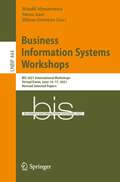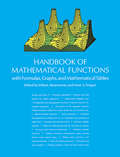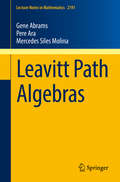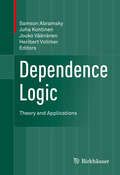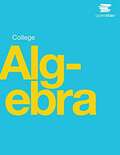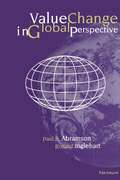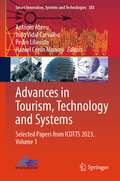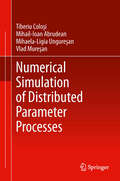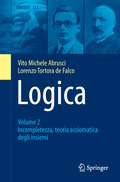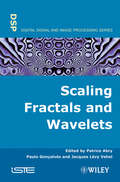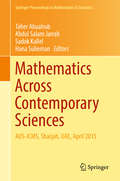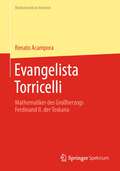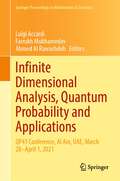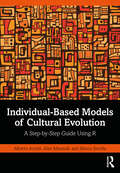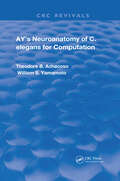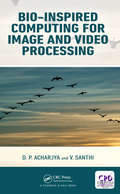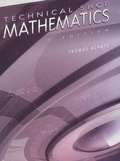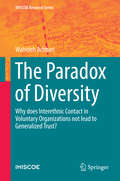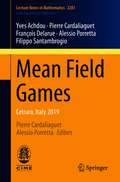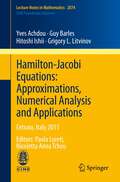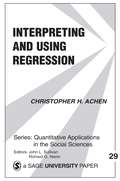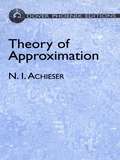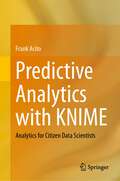- Table View
- List View
Business Information Systems Workshops: BIS 2021 International Workshops, Virtual Event, June 14–17, 2021, Revised Selected Papers (Lecture Notes in Business Information Processing #444)
by Witold Abramowicz Sören Auer Milena StróżynaThis book constitutes revised papers from the eight workshops which were held during June 2021 at the 24th International Conference on Business Information Systems, BIS 2021. The conference was planned to take place in Hannover, Germany, and changed to a fully online event due to the COVID-19 pandemic. There was a total of 67 submissions to all workshops of which 31papers were accepted for publication. The workshops included in this volume are: AKTB 2021: 12th Workshop on Applications of Knowledge-Based Technologies in Business BisEd 2021: BIS Education: Trends and Challenges DigBD 2021: 1st Workshop on Digitization in the Flux of Big Data Scenarios DigEx 2021: 3rd International Workshop on transforming the Digital Customer Experience iCRM 2021: 6th International Workshop on Integrated Social CRM QOD 2021: 4th Workshop on Quality of Open Data BITA 2021: 12th Workshop on Business and IT Alignment BSCT 2021: 4th Workshop on Blockchain and Smart Contract Technologies
Handbook of Mathematical Functions: with Formulas, Graphs, and Mathematical Tables
by Milton Abramowitz Irene A. StegunDespite the increasing use of computers, the basic need for mathematical tables continues. Tables serve a vital role in preliminary surveys of problems before programming for machine operation, and they are indispensable to thousands of engineers and scientists without access to machines. Because of automatic computers, however, and because of recent scientific advances, a greater variety of functions and a higher accuracy of tabulation than have been available until now are required.In 1954, a conference on mathematical tables, sponsored by M.I.T. and the National Science Foundation, met to discuss a modernization and extension of Jahnke and Emde's classical tables of functions. This volume, published 10 years later by the U.S. Department of Commerce, is the result. Designed to include a maximum of information and to meet the needs of scientists in all fields, it is a monumental piece of work, a comprehensive and self-contained summary of the mathematical functions that arise in physical and engineering problems.The book contains 29 sets of tables, some to as high as 20 places: mathematical constants; physical constants and conversion factors (6 tables); exponential integral and related functions (7); error function and Fresnel integrals (12); Bessel functions of integer (12) and fractional (13) order; integrals of Bessel functions (2); Struve and related functions (2); confluent hypergeometric functions (2); Coulomb wave functions (2); hypergeometric functions; Jacobian elliptic and theta functions (2); elliptic integrals {9); Weierstrass elliptic and related functions; parabolic cylinder functions {3); Mathieu functions (2); spheroidal wave functions (5); orthogonal polynomials (13); combinatorial analysis (9); numerical interpolation, differentiation and integration (11); probability functions (ll); scales of notation (6); miscellaneous functions (9); Laplace transforms (2); and others.Each of these sections is prefaced by a list of related formulas and graphs: differential equations, series expansions, special functions, and other basic relations. These constitute an unusually valuable reference work in themselves. The prefatory material also includes an explanation of the numerical methods involved in using the tables that follow and a bibliography. Numerical examples illustrate the use of each table and explain the computation of function values which lie outside its range, while the editors' introduction describes higher-order interpolation procedures. Well over100 figures illustrate the text.In all, this is one of the most ambitious and useful books of its type ever published, an essential aid in all scientific and engineering research, problem solving, experimentation and field work. This low-cost edition contains every page of the original government publication.
Leavitt Path Algebras
by Gene Abrams Pere Ara Mercedes Siles MolinaThis book offers a comprehensive introduction by three of the leading experts in the field, collecting fundamental results and open problems in a single volume. Since Leavitt path algebras were first defined in 2005, interest in these algebras has grown substantially, with ring theorists as well as researchers working in graph C*-algebras, group theory and symbolic dynamics attracted to the topic. Providing a historical perspective on the subject, the authors review existing arguments, establish new results, and outline the major themes and ring-theoretic concepts, such as the ideal structure, Z-grading and the close link between Leavitt path algebras and graph C*-algebras. The book also presents key lines of current research, including the Algebraic Kirchberg Phillips Question, various additional classification questions, and connections to noncommutative algebraic geometry. Leavitt Path Algebras will appeal to graduate students and researchers working in the field and related areas, such as C*-algebras and symbolic dynamics. With its descriptive writing style, this book is highly accessible.
Candy 1 to 20
by Pam Abrams Bruce Wolf Laurie WolfReaders will devour this delicious counting book from lollipops to licorice strings, from 1 to 20!
Dependence Logic
by Samson Abramsky Juha Kontinen Jouko Väänänen Heribert VollmerIn this volume, different aspects of logics for dependence and independence are discussed, including both the logical and computational aspects of dependence logic, and also applications in a number of areas, such as statistics, social choice theory, databases, and computer security. The contributing authors represent leading experts in this relatively new field, each of whom was invited to write a chapter based on talks given at seminars held at the Schloss Dagstuhl Leibniz Center for Informatics in Wadern, Germany (in February 2013 and June 2015) and an Academy Colloquium at the Royal Netherlands Academy of Arts and Sciences (March 2014). Altogether, these chapters provide the most up-to-date look at this developing and highly interdisciplinary field and will be of interest to a broad group of logicians, mathematicians, statisticians, philosophers, and scientists. Topics covered include a comprehensive survey of many propositional, modal, and first-order variants of dependence logic; new results concerning expressive power of several variants of dependence logic with different sets of logical connectives and generalized dependence atoms; connections between inclusion logic and the least-fixed point logic; an overview of dependencies in databases by addressing the relationships between implication problems for fragments of statistical conditional independencies, embedded multivalued dependencies, and propositional logic; various Markovian models used to characterize dependencies and causality among variables in multivariate systems; applications of dependence logic in social choice theory; and an introduction to the theory of secret sharing, pointing out connections to dependence and independence logic.
College Algebra
by Jay Abramson OpenStaxCollege Algebra provides a comprehensive exploration of algebraic principles and meets scope and sequence requirements for a typical introductory algebra course. The modular approach and richness of content ensure that the book meets the needs of a variety of courses. College Algebra offers a wealth of examples with detailed, conceptual explanations, building a strong foundation in the material before asking students to apply what they’ve learned.
Value Change in Global Perspective
by Paul R. AbramsonIn this pioneering work, Paul R. Abramson and Ronald Inglehart show that the gradual shift from Materialist values (such as the desire for economic and physical security) to Post-materialist values (such as the desire for freedom, self-expression, and the quality of life) is in all likelihood a global phenomenon. Value Change in Global Perspectiveanalyzes over thirty years worth of national surveys in European countries and presents the most comprehensive and nuanced discussion of this shift to date. By paying special attention to the way generational replacement transforms values among mass publics, the authors are able to present a comprehensive analysis of the processes through which values change. In addition,Value Change in Global Perspectiveanalyzes the 1990-91 World Values Survey, conducted in forty societies representing over seventy percent of the world's population. These surveys cover an unprecedentedly broad range of the economic and political spectrum, with data from low-income countries (such as China, India, Mexico, and Nigeria), newly industrialized countries (such as South Korea) and former state-socialist countries in Eastern Europe and the former Soviet Union. This data adds significant new meaning to our understanding of attitude shifts throughout the world. Value Change in Global Perspectivehas been written to meet the needs of scholars and students alike. The use of percentage, percentage differences, and algebraic standardization procedures will make the results easy to understand and useful in courses in comparative politics and in public opinion. Paul R. Abramson is Professor of Political Science, Michigan State University. Ronald Inglehart is Professor of Political Science and Program Director, Institute for Social Research, University of Michigan.
Advances in Tourism, Technology and Systems: Selected Papers from ICOTTS 2023, Volume 1 (Smart Innovation, Systems and Technologies #383)
by António Abreu João Vidal Carvalho Pedro Liberato Hazael Cerón MonroyThis book features a collection of high-quality research papers presented at the International Conference on Tourism, Technology and Systems (ICOTTS 2023), held at Anáhuac University, Bacalar, Mexico, from 2 to 4 November 2023. The book is divided into two volumes, and it covers the areas of technology in tourism and the tourist experience, generations and technology in tourism, digital marketing applied to tourism and travel, mobile technologies applied to sustainable tourism, information technologies in tourism, digital transformation of tourism business, e-tourism and tourism 2.0, big data and management for travel and tourism, geotagging and tourist mobility, smart destinations, robotics in tourism, and information systems and technologies.
Numerical Simulation of Distributed Parameter Processes
by Mihail-Ioan Abrudean Vlad Muresan Tiberiu Colosi Mihaela-Ligia UnguresanThe present monograph defines, interprets and uses the matrix of partial derivatives of the state vector with applications for the study of some common categories of engineering. The book covers broad categories of processes that are formed by systems of partial derivative equations (PDEs), including systems of ordinary differential equations (ODEs). The work includes numerous applications specific to Systems Theory based on Mpdx, such as parallel, serial as well as feed-back connections for the processes defined by PDEs. For similar, more complex processes based on Mpdx with PDEs and ODEs as components, we have developed control schemes with PID effects for the propagation phenomena, in continuous media (spaces) or discontinuous ones (chemistry, power system, thermo-energetic) or in electro-mechanics (railway - traction) and so on. The monograph has a purely engineering focus and is intended for a target audience working in extremely diverse fields of application (propagation phenomena, diffusion, hydrodynamics, electromechanics) in which the use of PDEs and ODEs is justified.
Logica: Volume 2 - Incompletezza, teoria assiomatica degli insiemi (UNITEXT #111)
by Vito Michele Abrusci Lorenzo Tortora de FalcoL'opera si propone come testo di riferimento per acquisire una solida preparazione specialistica nella Logica, presentando in maniera rigorosa ed innovativa argomenti tradizionalmente affrontati nei corsi universitari di secondo livello. Questo secondo volume, che completa l'opera, presenta le basi della teoria della ricorsività, l'aritmetica di Peano ed i teoremi di incompletezza, gli assiomi della teoria assiomatica degli insiemi di Zermelo-Fraenkel e la teoria degli ordinali e dei cardinali che ne deriva.
Scaling, Fractals and Wavelets (Wiley-iste Ser.)
by Patrice Abry Paulo Gonçalves Jacques Lévy VéhelScaling is a mathematical transformation that enlarges or diminishes objects. The technique is used in a variety of areas, including finance and image processing. This book is organized around the notions of scaling phenomena and scale invariance. The various stochastic models commonly used to describe scaling ? self-similarity, long-range dependence and multi-fractals ? are introduced. These models are compared and related to one another. Next, fractional integration, a mathematical tool closely related to the notion of scale invariance, is discussed, and stochastic processes with prescribed scaling properties (self-similar processes, locally self-similar processes, fractionally filtered processes, iterated function systems) are defined. A number of applications where the scaling paradigm proved fruitful are detailed: image processing, financial and stock market fluctuations, geophysics, scale relativity, and fractal time-space.
Mathematics Across Contemporary Sciences
by Taher Abualrub Abdul Salam Jarrah Sadok Kallel Hana SuliemanThis work presents invited contributions from the second "International Conference on Mathematics and Statistics" jointly organized by the AUS (American University of Sharjah) and the AMS (American Mathematical Society). Addressing several research fields across the mathematical sciences, all of the papers were prepared by faculty members at universities in the Gulf region or prominent international researchers. The current volume is the first of its kind in the UAE and is intended to set new standards of excellence for collaboration and scholarship in the region.
Evangelista Torricelli: Mathematiker des Großherzogs Ferdinand II. der Toskana (Mathematik im Kontext)
by Renato AcamporaDie meisten Nichtmathematiker werden Torricelli durch das nach ihm benannte Ausflussgesetz kennen, wonach die Geschwindigkeit eines aus einem Gefäss austretenden Wasserstrahls proportional zur Quadratwurzel aus der Füllhöhe ist, ebenso wie durch seinen Nachweis des Luftdrucks mithilfe seines Vakuumexperiments. Viel bedeutender aber sind seine Leistungen auf dem Gebiet der Mathematik als virtuoser Vertreter von Cavalieris umstrittener Indivisiblenmethode, wobei er seine Ergebnisse aber stets mit Beweisen nach der allgemein anerkannten „Art der Alten“ absicherte. Auf diese Weise gelang ihm die Quadratur der Parabeln und Hyperbeln höherer Ordnung, der Zykloide, der logarithmischen Spirale (ebenso wie deren Rektifikation) und die Bestimmung der Schwerpunkte zahlreicher ebener und räumlicher Figuren.
Infinite Dimensional Analysis, Quantum Probability and Applications: QP41 Conference, Al Ain, UAE, March 28–April 1, 2021 (Springer Proceedings in Mathematics & Statistics #390)
by Luigi Accardi Farrukh Mukhamedov Ahmed Al RawashdehThis proceedings volume gathers selected, peer-reviewed papers presented at the 41st International Conference on Infinite Dimensional Analysis, Quantum Probability and Related Topics (QP41) that was virtually held at the United Arab Emirates University (UAEU) in Al Ain, Abu Dhabi, from March 28th to April 1st, 2021. The works cover recent developments in quantum probability and infinite dimensional analysis, with a special focus on applications to mathematical physics and quantum information theory. Covered topics include white noise theory, quantum field theory, quantum Markov processes, free probability, interacting Fock spaces, and more. By emphasizing the interconnection and interdependence of such research topics and their real-life applications, this reputed conference has set itself as a distinguished forum to communicate and discuss new findings in truly relevant aspects of theoretical and applied mathematics, notably in the field of mathematical physics, as well as an event of choice for the promotion of mathematical applications that address the most relevant problems found in industry. That makes this volume a suitable reading not only for researchers and graduate students with an interest in the field but for practitioners as well.
Advances in Economics and Econometrics
by Daron Acemoglu Manuel Arellano Eddie DekelThis is the third of three volumes containing edited versions of papers and commentaries presented at invited symposium sessions of the Tenth World Congress of the Econometric Society, held in Shanghai in August 2010. The papers summarize and interpret key developments in economics and econometrics, and they discuss future directions for a wide variety of topics, covering both theory and application. Written by the leading specialists in their fields, these volumes provide a unique, accessible survey of progress on the discipline. The third volume primarily addresses econometrics, with specific focuses on the econometrics of industrial organization, macroeconometrics, econometric theory, empirical microeconomics, time series and panels, and the Mirrlees Review on tax reform in the twenty-first century.
Individual-Based Models of Cultural Evolution: A Step-by-Step Guide Using R
by Alberto Acerbi Alex Mesoudi Marco SmollaIndividual-Based Models of Cultural Evolution shows readers how to create individual-based models of cultural evolution using the programming language R. The field of cultural evolution has emerged in the last few decades as a thriving, interdisciplinary effort to understand cultural change and cultural diversity within an evolutionary framework and using evolutionary tools, concepts, and methods. Given its roots in evolutionary biology, much of cultural evolution is grounded in, or inspired by, formal models. Yet many researchers interested in cultural evolution come from backgrounds that lack training in formal modelling, such as psychology, anthropology or archaeology. This book addresses that gap. It provides example code in R for readers to run their own models, moving from very simple models of the basic processes of cultural evolution, such as biased transmission and cultural mutation, to more advanced topics such as the evolution of social learning, demographic effects, and social network analysis. Features of this book: Recreates existing models in the literature to show how these were created and to enable readers to have a better understanding of their significance and how to apply them to their own research questions Provides full R code to realize models and analyse and plot outputs, with line-by-line analysis Requires no previous knowledge of the field of cultural evolution, and only very basic programming knowledge This is an essential resource for researchers and students interested in cultural evolution, including disciplines such as psychology, anthropology, archaeology, and biology as well as sociology and digital humanities.
Ay's Neuroanatomy of C. Elegans for Computation (Routledge Revivals)
by Theodore B. Achacoso William S. YamamotoFirst published in 1992, AY's Neuroanatomy of C. elegans for Computation provides the neural circuitry database of the nematode Caenorhabditis elegans, both in printed form and in ASCII files on 5.25-inch diskettes (for use on IBM® and compatible personal computers, Macintosh® computers, and higher level machines). Tables of connections among neuron classes, synapses among individual neurons, gap junctions among neurons, worm cells and their embryonic origin, and synthetically derived neuromuscular connections are presented together with the references from which the data were compiled and edited. Sample data files and source codes of FORTRAN and BASIC programs are provided to illustrate the use of mathematical tools for any researcher or student interested in examining a natural neural network and discovering what makes it tick.
Bio-Inspired Computing for Image and Video Processing
by D. P. Acharjya V. SanthiIn recent years bio-inspired computational theories and tools have developed to assist people in extracting knowledge from high dimensional data. These differ in how they take a more evolutionary approach to learning, as opposed to traditional artificial intelligence (AI) and what could be described as 'creationist' methods. Instead bio-inspired computing takes a bottom-up, de-centralized approach that often involves the method of specifying a set of simple rules, a set of simple organisms which adhere to those rules, and of iteratively applying those rules. Bio-Inspired Computing for Image and Video Processing covers interesting and challenging new theories in image and video processing. It addresses the growing demand for image and video processing in diverse application areas, such as secured biomedical imaging, biometrics, remote sensing, texture understanding, pattern recognition, content-based image retrieval, and more. This book is perfect for students following this topic at both undergraduate and postgraduate level. It will also prove indispensable to researchers who have an interest in image processing using bio-inspired computing.
Technical Shop Mathematics
by Thomas Achatz Kathleen McKenzie John AndersonSuitable for home study, classroom use, or as a superior reference guide for the shop professional, this practical text presents a review and introduction to basic shop mathematics in a straightforward manner. Its logical format progresses from arithmetical operations through measurement systems to basic algebra for shop-formula solving skills, practical geometry with shop examples and applications, and trigonometry, emphasizing its valuable use in the shop and in the trades. Numerous shop-related problems requiring practical application of principles are interspersed throughout, as well as a wealth of worked-out study examples designed to reinforce concepts.
The Paradox of Diversity
by Wahideh AchbariThis book is about ethnic diversity in voluntary organizations and seeks to explain whether intergroup contact contributes to the development of generalized trust. It relies on a novel multilevel design and data from Amsterdam in which 40 voluntary organizations and 463 participants have been sampled. Contrary to conventional wisdom, this book argues that cognitive processes are contributing more toward the evaluation of strangers or generalized trust than interethnic contact. Since trusting unknown people is essentially a risky endeavor, this suggests that participants of both association types who report trusting strangers can afford to do so, because they are better educated, have a more positive worldview, and have had fewer negative life experiences. That is to say, they are socially more successful and view their future as more promising. Previous findings are inconclusive since most studies that conclude diversity has led to less generalized trust do not include interethnic contact directly in their analyses. These studies also downplay the importance of cognitive processes, which may shape generalized trust. What is more, people join ethnically diverse civic groups, because they already have more trustful attitudes, rather than learning to trust through interethnic contact. Despite the recent multiculturalist backlash, this book demonstrates that participation in ethno-national organizations does not pose a threat to social cohesion. The analysis in this book serves to build a general theory of trust that moves beyond emphasizing interaction between people who are different from each other, but one that includes the importance of cognition.
Mean Field Games: Cetraro, Italy 2019 (Lecture Notes in Mathematics #2281)
by Yves Achdou Pierre Cardaliaguet François Delarue Alessio Porretta Filippo SantambrogioThis volume provides an introduction to the theory of Mean Field Games, suggested by J.-M. Lasry and P.-L. Lions in 2006 as a mean-field model for Nash equilibria in the strategic interaction of a large number of agents. Besides giving an accessible presentation of the main features of mean-field game theory, the volume offers an overview of recent developments which explore several important directions: from partial differential equations to stochastic analysis, from the calculus of variations to modeling and aspects related to numerical methods. Arising from the CIME Summer School "Mean Field Games" held in Cetraro in 2019, this book collects together lecture notes prepared by Y. Achdou (with M. Laurière), P. Cardaliaguet, F. Delarue, A. Porretta and F. Santambrogio.These notes will be valuable for researchers and advanced graduate students who wish to approach this theory and explore its connections with several different fields in mathematics.
Hamilton-Jacobi Equations: Paola Loreti, Nicoletta Anna Tchou
by Yves Achdou Paola Loreti Nicoletta Tchou Guy Barles Grigory L. Litvinov Hitoshi IshiiThese Lecture Notes contain the material relative to the courses given at the CIME summer school held in Cetraro, Italy from August 29 to September 3, 2011. The topic was "Hamilton-Jacobi Equations: Approximations, Numerical Analysis and Applications". The courses dealt mostly with the following subjects: first order and second order Hamilton-Jacobi-Bellman equations, properties of viscosity solutions, asymptotic behaviors, mean field games, approximation and numerical methods, idempotent analysis. The content of the courses ranged from an introduction to viscosity solutions to quite advanced topics, at the cutting edge of research in the field. We believe that they opened perspectives on new and delicate issues. These lecture notes contain four contributions by Yves Achdou (Finite Difference Methods for Mean Field Games), Guy Barles (An Introduction to the Theory of Viscosity Solutions for First-order Hamilton-Jacobi Equations and Applications), Hitoshi Ishii (A Short Introduction to Viscosity Solutions and the Large Time Behavior of Solutions of Hamilton-Jacobi Equations) and Grigory Litvinov (Idempotent/Tropical Analysis, the Hamilton-Jacobi and Bellman Equations).
Interpreting and Using Regression
by Christopher H. AchenInterpreting and Using Regression sets out the actual procedures researchers employ, places them in the framework of statistical theory, and shows how good research takes account both of statistical theory and real world demands. Achen builds a working philosophy of regression that goes well beyond the abstract, unrealistic treatment given in previous texts.
Theory of Approximation (Dover Books on Mathematics)
by N. I. AchieserA pioneer of many modern developments in approximation theory, N. I. Achieser designed this graduate-level text from the standpoint of functional analysis. The first two chapters address approximation problems in linear normalized spaces and the ideas of P. L. Tchebysheff. Chapter III examines the elements of harmonic analysis, and Chapter IV, integral transcendental functions of the exponential type. The final two chapters explore the best harmonic approximation of functions and Wiener's theorem on approximation. Professor Achieser concludes this exemplary text with an extensive section of problems and applications (elementary extremal problems, Szego's theorem, the Carathéodory-Fejér problem, and more).
Predictive Analytics with KNIME: Analytics for Citizen Data Scientists
by Frank AcitoThis book is about data analytics, including problem definition, data preparation, and data analysis. A variety of techniques (e.g., regression, logistic regression, cluster analysis, neural nets, decision trees, and others) are covered with conceptual background as well as demonstrations of KNIME using each tool. The book uses KNIME, which is a comprehensive, open-source software tool for analytics that does not require coding but instead uses an intuitive drag-and-drop workflow to create a network of connected nodes on an interactive canvas. KNIME workflows provide graphic representations of each step taken in analyses, making the analyses self-documenting. The graphical documentation makes it easy to reproduce analyses, as well as to communicate methods and results to others. Integration with R is also available in KNIME, and several examples using R nodes in a KNIME workflow are demonstrated for special functions and tools not explicitly included in KNIME.
